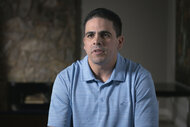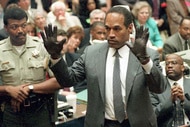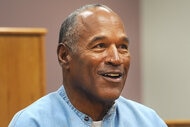Create a free profile to get unlimited access to exclusive videos, breaking news, sweepstakes, and more!
Athletes Who May Have Suffered From CTE — And The Tragic Outcomes
Chronic traumatic encephalopathy is a degenerative brain disease found in athletes, military veterans, and other people who have suffered a history of repetitive brain trauma.

The parents of Washington State quarterback Tyler Hilinski, who committed suicide earlier this year, revealed on Tuesday that their son had chronic traumatic encephalopathy (CTE) at the time of his death.
Chronic traumatic encephalopathy is a degenerative brain disease found in athletes, military veterans, and other people who have suffered a history of repetitive brain trauma.
“It was a shock, to get those results and to find out that he had it," his mom Kym Hilinski said on NBC's Today show. "And to realize that the sport that he loved may have contributed to that diagnosis."
Hilinski was only 21.
New studies are revealing that CTE is quite common: A Boston University study found that a whopping 110 of 111 deceased NFL players showed the disease. CTE can lead to uncontrollable aggression, lapses in judgment, mood swings, violence and suicidal tendencies.
The following people are a few high profile athletes who may have or have had CTE. However, the disease can only be definitively diagnosed after death.
Aaron Hernandez
In November, researchers at Boston University revealed that at the time of his suicide, Aaron Hernandez had been suffering from the most severe case of chronic traumatic encephalopathy (CTE) ever discovered in a person his age.
The 27-year-old, and former New England Patriots tight end, led a severely violent life. He was serving a life sentence for the 2013 murder of Odin Lloyd when he hung himself inside his prison cell by a bedsheet in 2017. Five days before his death, Hernandez had been acquitted of a different double murder that had occurred after a shooting incident in a Boston nightclub.
A post-mortem study on his brain revealed that Hernandez had immense damage to his frontal lobe, which is the part of the brain that controls judgment and impulse control. His amygdala, which is responsible for processing emotions, had also been severely affected.
Dave Duerson
He won the Super Bowl in 1985 while playing with the Chicago Bears. Dave Duerson played safety in the NFL for 11 seasons, seven of which were with the Bears before retiring from an impressive career in 1993. He ended his life by suicide at the age of 50 in 2011. It appears that he may have been aware that he was suffering from severe brain trauma because when he committed suicide, he left behind a note asking that his brain be given to the NFL's Study of Traumatic Encephalopathy Brain Bank, ESPN reported. He also shot himself in the chest, presumably to not destroy his brain. His brain was studied and he did in fact suffer from CTE.
“Dave Duerson had classic pathology of CTE and no evidence of any other disease," Dr. Ann McKee who worked at the Brain Bank said, "and he has severe involvement of all the [brain] structures that affect things like judgment, inhibition, impulse control, mood and memory."
O.J. Simpson
Could O.J. Simpson be another victim of CTE? The star NFL player was charged with the murders of his ex wife Nicole Brown Simpson and her friend Ronald Goldman in 1994. After one of the most highly televised and polarizing trials in history. O.J. was eventually found not guilty. However, a civil court jury found him liable for the deaths of his ex-wife and Goldman. He was convicted of armed robbery and kidnapping in 2008 for trying to retrieve his sports memorabilia in 2007.
Bennet Omalu, the doctor who first identified CTE has recently suggested that Simpson could have CTE.
“I would bet my medical license on it,” said Omalu in a 2016 interview with ABC News. “He was exposed to thousands of blunt-force trauma of his brain.”
Jovan Belcher
Kansas City Chiefs linebacker Jovan Belcher shot his 22-year-old girlfriend Kasandra Perkins to death in 2012 before killing himself. A year later, signs of CTE were found in his brain.
The 25-year-old shot Perkins while she was taking care of their baby daughter. The baby survived. After shooting his girlfriend, he fled to the Chiefs' training facility, where killed himself by shooting himself in the head in front of then-general manager Scott Pioli and then-coach Romeo Crennel, The Associated Press reported.
An autopsy on Belcher’s brain revealed that he suffered extensive brain injuries. After the murder-suicide, his mother Cheryl Shepherd, filed a lawsuit alleging that the football team didn’t provide adequate medical care to Belcher. It’s unclear if the lawsuit was ever resolved.
Kellen Winslow Jr.
He played for the Tampa Bay Buccaneers, Seattle Seahawks, New England Patriots, and New York Jets. An impressive career but sadly, Kellen Winslow, 34, also has an impressive rap sheet and right now he's facing life behind bars for the alleged kidnappings and rapes of multiple women in Encinitas, California over the last three months, Sports Illustrated reported. He has pleaded not guilty to raping two women, ages 54 and 59. He's also accused of exposing himself to another 55-year-old woman and breaking into the homes of two women, ages 71 and 86, with the intent of committing a sex crime. He is currently awaiting trial and it has been theorized by Sports Illustrated and other publications that his lawyers may use CTE as a defense. If they do, it could possibly lessen Winslow's sentence and it could also delay the trial, USA Today reported.
Junior Seau
A linebacker for the National Football League, Junior Seau ended his own life in 2013 at the age of 43.
"I think it's important for everyone to know that Junior did indeed suffer from CTE," Gina Seau told ESPN after his death. "It's important that we take steps to help these players. We certainly don't want to see anything like this happen again to any of our athletes."
Seau had shot himself in the heart, and with hours of his death, researchers began calling his family so that they could study Seau’s brain. The scientists who studied his brain concluded that his CTE was the result of two decades worth of head injuries.
"What was found in Junior Seau's brain was cellular changes consistent with CTE," said Dr. Russell Lonser, chairman of the Department of Neurological Surgery at Ohio State University told ABC News.
[Photos: Getty Images]






























